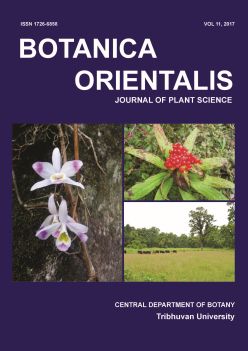Fuelwood resources and their use pattern by Bhotia community in Niti valley, Western Himalaya
DOI:
https://doi.org/10.3126/botor.v11i0.21025Keywords:
Bhotia community, Nanda Devi National Park, Trans-Himalaya, Use IndexAbstract
The local communities of the Himalaya have been using fuel wood as one of the major sources of energy since millennia. Their dependency on these resources as primary source of fuel wood has resulted in unsustainable pressures on the forests. The present communication aims to access the fuel wood resource and consumption pattern of Bhotia, an ethnic community in a cold arid and buffer zone of Nanda Devi Biosphere Reserve, i.e. Niti valley in the Western Himalaya. Within the Niti valley, 87 households in six villages were surveyed using open and close-ended structured questionnaire. Use Index (I%) of each fuel wood species was calculated to evaluate the key species used by the inhabitants and their preferences. The study revealed use of 10 species for fuel wood (five species each of tree and shrub) by the Bhotias. Pinus wallichiana (I = 96.6%) followed by Cedrus deodara (93.1%) were the preferred tree species for fuel wood, while among shrubs, Juniperus indica and J. communis were extensively used. Fuel wood consumption in the Niti valley was much lower (1.6±0.2 kg household-1 day-1) than other villages in the Greater Himalaya (4.9±0.4 kg household-1 day-1). The seasonally employed which formed 23% of the surveyed households, collected almost twice as much fuel wood than the employed households (9.2±0.4 and 5.2±0.4 quintals season-1, respectively). As the area is characterized by sparse vegetation cover, low primary productivity and short growing season, and is thus highly susceptible to irreversible changes of natural habitats. The study suggests that providing alternate and non-conventional energy sources such as solar cookers and fuel efficient portable ovens to the inhabitants at subsidized rates could reduce the pressure on nearby forests.
Botanica Orientalis – Journal of Plant Science (2017) 11: 1–6




